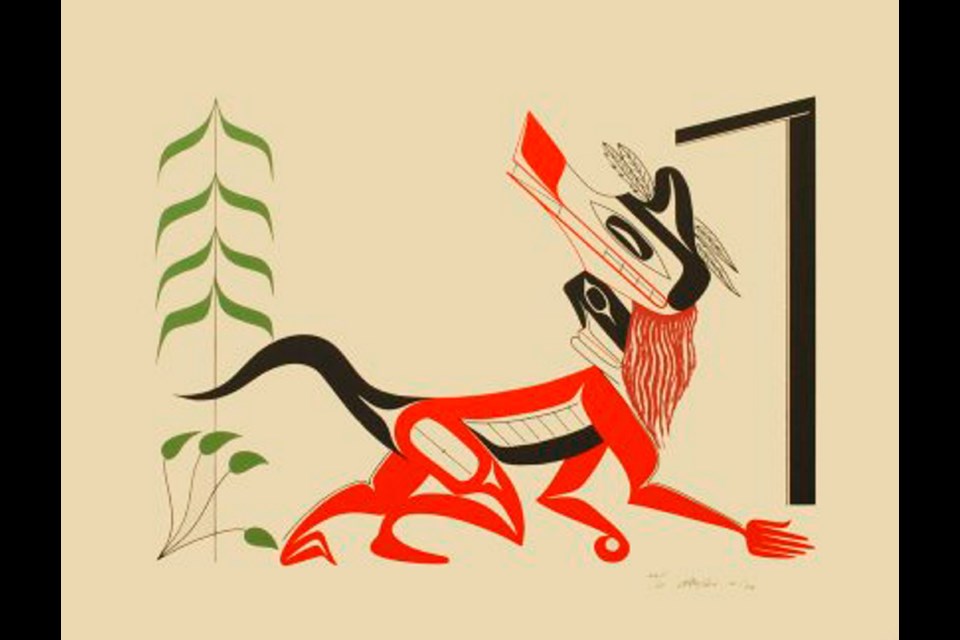 Alcheringa Gallery is presenting an exhibition of more than 40 screen prints by the Ditidaht artist Art Thompson (1948-2003). In an illustrious career, cut short by his death from cancer, Thompson was an esteemed teacher and carver, and his legacy of more than 100 screen prints lives on.
Alcheringa Gallery is presenting an exhibition of more than 40 screen prints by the Ditidaht artist Art Thompson (1948-2003). In an illustrious career, cut short by his death from cancer, Thompson was an esteemed teacher and carver, and his legacy of more than 100 screen prints lives on.
Thompson was born in the Nuu-chah-nulth village of Whyac, where Nitinat Lake flows into the Pacific Ocean. He was fortunate to have been brought up there in the cultural life of his people, and his early interest in art was reinforced by the care and teaching of his paternal grandfather. As was all too often the case, he was taken from his home and spent nine bitter years in residential school at Port Alberni, which ended with his graduation in 1964.
Yet Thompson was able to overcome this, and studied fine arts at Camosun College and then at Emily Carr Institute, where he first began to create screen prints. Prints were a new form for native art, an excellent medium to utilize the brilliant graphic idiom of First Nations design and a wonderfully democratic way to share the stories they represent. Screen prints were an easy entry to the marketplace for young artists, and made ideal gifts for naming ceremonies, potlatches and other community events.
Thompson moved to Victoria, where he worked with screen-printer Vincent Rickard of Open Pacific Graphics to create the images now on show, prints that demonstrate the evolution of Thompson’s unique interpretation of the Nuu-chah-nulth graphic style. This is distinct from the curvaceous Kwak waka wak’w style, which is full of volume and complex formline design; and from the essentially simpler Coast Salish motifs. Nuu-chah-nulth masks and headdresses are often created with flat sides that meet at the front, allowing for the free play of clear graphic forms in red and blue, and imagery not necessarily attached to the carved forms.
Thompson was known as a wonderful carver, creating totem poles for Stanford University in California and the University of British Columbia. His elaborate transformation masks, one of which is on show, are legendary. And to aid the cultural life of his people, he created many dance screens, large designs painted on canvas, which were easily adapted for his screen prints. Another specialty was the painting of drum heads, and the resulting circular or octagonal images are among his most sought-after designs.
Elaine Monds, director of Alcheringa Gallery, remembered him fondly.
“He launched a private lawsuit agains the individuals who abused him at the Port Alberni Residential School, which eventually set in motion the Truth and Reconciliation Commission. He attended the trial in complete ceremonial regalia, covered in ash, and much of what he said was being said for the first time. He suffered a great deal of abuse in school, and it affected his life forever.” As a mentor to young artists, he made good on the evil that had been visited upon him.
“Had he lived longer, he might have been free of the past, but it was very much with him when we knew him. He was often with us in the gallery,” she recalled. “He used to come to all our openings, to drum and sing. We had a strong connection to him and knew him well. We often had his work, but we never had a solo show for him.”
Thompson was a full-time professional artist and teacher, generous with his time and with an exacting nature.
“It was very hard to please Art,” Monds smiled. Throughout his life, Thompson was closely involved with other leading Nuu-chah-nulth artists Joe David, Tim Paul and Ron Hamilton. Monds, who was present at his funeral in Port Alberni, reported that “he and Ron Hamilton were, as Hamilton said, lifelong friend-enemies. [Hamilton] orated for two hours without stopping. And two crawling wolves, one of his constant motifs, were crawling around under [Thompson’s] coffin. We stood the whole time. The place was packed to the rafters. It was a very moving testimony to Art.”
The screen prints cover a huge range of subjects, including octopi, barnacles and a remarkable anthropomorphic cedar tree. Some include simple geometric shapes used to delineate the context of the imagery, such as the dancer’s house or the rocks the shellfish are attached to. Others include rainbows, and the innermost realm of his transformation mask is painted with a galaxy of stars on a softly sponged white ground.
Looking at the earlier works, some of which were part of entire editions made to be given away at potlatches or naming ceremonies, Monds mused that at the time “no one realized how important they would be, and so they were not kept very well.” But the odd wrinkle or stain is not really a problem. Though these early works are rare, they are not prohibitively expensive.
Art Thompson’s work was extensively featured in The Legacy (1971 and 1984) and Out of the Mist (1999), landmark exhibits from the Royal British Columbia Museum. It is now extensively represented in the collections of the University of Victoria and the Canadian Museum of Civilization. In conclusion, Monds said: “Art Thompson will be remembered as one of the great artists of the Coast in his generation, I am very sure. He didn’t live long enough to be a ‘grand old man’ but was very respected — and he lived long enough to be admired as an artist, and valued.”
Art Thompson print retrospective at Alcheringa Gallery (621 Fort St., alcheringa-gallery.com, 250-383-8224) until March 9.



